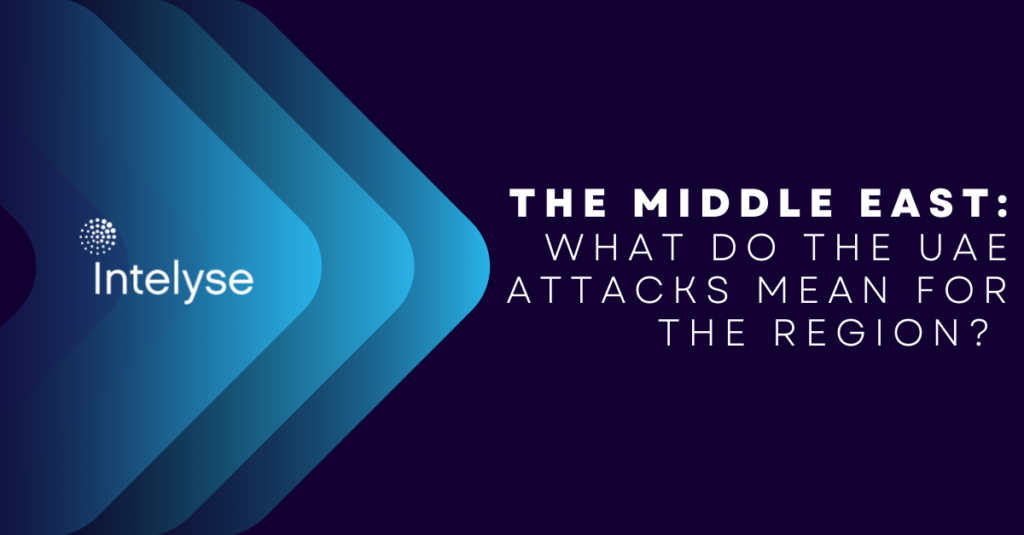

On 17 January, a Houthi aerial attack conducted via one or more small drones hit three fuel trucks at the Musaffah industrial zone in Abu Dhabi, United Arab Emirates, causing three explosions. Three people died and six others were injured. Another explosion was reported at Abu Dhabi airport, with no operational disruptions. On 24 January, Emirati and US officials confirmed the interception of a Houthi missile attack targeting the UAE. The attacks coincided with an increase in cross-border attacks from Yemen into Saudi Arabia. The latest escalation comes amid ongoing nuclear deal talks as well as talks between Iran and Saudi Arabia regarding a ceasefire in Yemen. The attack on Abu Dhabi has escalated tensions in the region at a time when regional powers were working to resolve tensions through diplomacy.
On 13 January, four days before the first attack, pro-Iranian militia threatened to attack the UAE after accusing it of interfering in Iraqi politics. They claimed the UAE tampered with the Iraqi elections and united Iraqi Sunnis to nominate Mohamed Al-Halbousi as speaker of parliament for a second term, an outcome which they tried to prevent. After the attack, Alwiyat al-Waad al-Haq, a shadow group that has been dormant after claiming a drone attack on Saudi Arabia in January 2021 re-emerged and stated the attack was “only the beginning”. Kataib Hezbollah spokesperson Abu Ali Al-Askari and Asaib Ahl Al-Haq leader Qais Khazali then issued statements supporting the attack and issuing further threats to the UAE. The fact that Iraqi paramilitary groups signaled that an attack on the UAE was possible demonstrates growing solidarity among Iranian proxies. The IRGC’s propaganda and messaging systems are becoming increasingly complex and aimed at causing confusion, diverting any blame away from Iran. The fact that the Iraqi militia groups appeared aware of the attacks indicates Iran was likely informed and gave the Houthis the greenlight to proceed.
The UAE has urged the US to redesignate the Houthis as a terrorist organization despite calls by rights organization that this would make humanitarian missions difficult in Houthi-controlled areas. On 21 January, a coalition airstrike hit a Houthi-controlled military police camp in Sanaa. International media reported that the airstrike caused about 60 civilian casualties among the detainees of a prison located inside the camp, though it must be noted that casualty figures are released by the Houthis. The latest wave of attacks on the Gulf countries have re-aligned Emirati and Saudi policies in Yemen, following a period of increasing competition between the two states.
The UAE and Saudi Arabia are technologically militarily superior to the Houthis yet unable to defeat them. The UAE’s recent realignment gives Saudi Arabia significant leverage over the Houthis and Iran during talks. A ceasefire is possible over the coming months and arguably, the Houthis need it more than ever given the escalation in attacks by the Saudi-led coalition. The condemnations made by the UAE, Saudi Arabia, and the US have been limited to blaming the Houthis, without mentioning Iran. This indicates that neither side is willing to jeopardize the progress made individually with Iran. The nuclear talks are expected to remain unaffected given that Iran’s proxy warfare remains a separate issue from its nuclear program during talks with Western powers.
Intelyse will monitor and analyse the developing economic, political and security situation.
Stay up to date with our Middle East Regional Report, Yemen or KSA subscription services.
Our team of analysts are also available for a consultative approach to risk
in the region.
Sign up for a free trial or consultation.
Yemen Services
Detailed daily, weekly, monthly reports and platform access delivering situational awareness, threat analysis and forecasted economic, political and security outlook.
KSA Services
Detailed daily, weekly, monthly reports and platform access delivering situational awareness, threat analysis and forecasted economic, political and security outlook.
Middle East Regional Report
A high-level overview and brief analysis of regional political, economic and security activity, distributed every fortnight.

